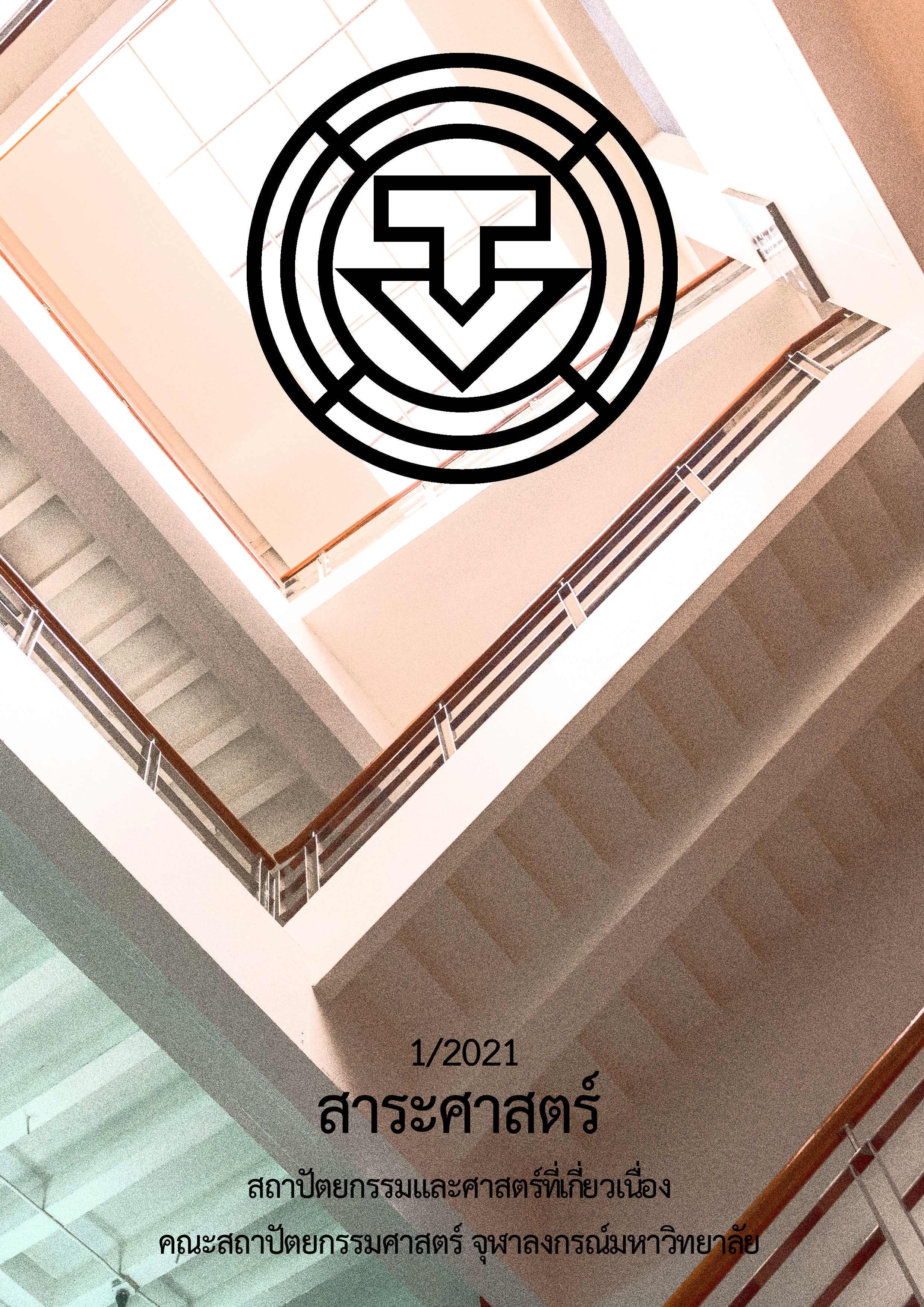การใช้พื้นที่ในงานภูมิสถาปัตยกรรมของคอนโดมิเนียมระดับกลางในกรุงเทพมหานคร
Main Article Content
บทคัดย่อ
งานภูมิสถาปัตยกรรมเป็นหนึ่งในปัจจัยสำคัญในการตัดสินใจเลือกซื้อคอนโดมิเนียมระดับกลาง ส่งผลให้งานออกแบบมีความหลากหลายเพื่อดึงดูดและเป็นจุดขายให้แก่โครงการ อย่างไรก็ตามยังไม่เคยมีการศึกษาวิจัยมาก่อนว่างานออกแบบภูมิสถาปัตยกรรมของคอนโดมิเนียมเหล่านี้ตอบสนองต่อการใช้งานมากน้อยเพียงใด งานวิจัยนี้จึงมีวัตถุประสงค์เพื่อศึกษาการใช้พื้นที่ในงานภูมิสถาปัตยกรรมของโครงการคอนโดมิเนียมระดับกลางในกรุงเทพมหานคร เพื่อนำไปสู่แนวทางการออกแบบที่เหมาะสมต่อการใช้งานในอนาคตต่อไป
วิธีการเก็บข้อมูล 4 ขั้นตอนคือ (1) กำหนดเกณฑ์ในการเลือกคอนโดมิเนียมกลุ่มตัวอย่าง (2) รวบรวมข้อมูลที่ผ่านการศึกษาทางด้านหลักการ แนวความคิด และวิธีดำเนินการ (3) การสำรวจและการสังเกตพฤติกรรมการใช้ของผู้ใช้พื้นที่โครงการคอนโดมิเนียม โดยมีขั้นตอนการสังเกตดังนี้ แบ่งพื้นที่ในการสำรวจ กำหนดช่วงเวลาเก็บข้อมูล และสังเกตพฤติกรรมการใช้งานพื้นที่โดยสรุปเป็นตารางการสังเกตการณ์ (4) การสัมภาษณ์ข้อมูลทั่วไปของผู้ใช้พื้นที่โครงการ และข้อมูลเกี่ยวกับพฤติกรรมการใช้งานพื้นที่คอนโดมิเนียมกลุ่มตัวอย่าง
ผลการศึกษาพบว่า ปัจจัยสำคัญที่ทำให้พื้นที่ในงานภูมิสถาปัตยกรรมมีการใช้หรือไม่ใช้งาน ได้แก่ (1) องค์ประกอบทางภูมิสถาปัตยกรรม เช่น การใช้ไม้ยืนต้น ศาลาสำหรับนั่งพักผ่อน วัสดุผิวหยาบป้องกันอันตรายที่เกิดจากการใช้งาน (2) การแบ่งพื้นที่กิจกรรมมีการกำหนดขอบเขตอย่างชัดเจน (3) รูปร่างของพื้นที่ทางภูมิสถาปัตยกรรมที่เหมาะสมต่อการใช้งานของผู้ใช้พื้นที่โครงการหลายกลุ่ม (4) ตำแหน่งที่ตั้งและความเชื่อมต่อระหว่างพื้นที่สร้างความต่อเนื่องของกิจกรรม
Article Details
เอกสารอ้างอิง
เชาวรัตน์ อรอมรรัตน์. (2561). การศึกษาพฤติกรรมการใช้พื้นที่และศึกษาปัจจัยที่มีอิทธิพลต่อพฤติกรรมการใช้งานพื้นที่รอบองค์พระปฐมเจดีย์. สาระศาสตร์, 2, 194-207.
บุญยิ่ง คงอาชาภัทร. (2562). โลนลี่มาร์เก็ต เทรนด์แรง เจาะตลาด คนเหงาไทย 26 ล้านคน. สืบค้นเมื่อ 5 ธันวาคม 2562, จากhttps://positioningmag.com/1228902fbclid=IwAR0DxVhOoTS7XRD6_rzYVj48exYQdurx0PSnCyqq1oWcgB2Dr16mIaXFT3Y
วิมลสิทธิ์ หรยางกูร. (2549). พฤติกรรมมนุษย์กับสภาพแวดล้อม: มูลฐานทางพฤติกรรมเพื่อการออกแบบและวางแผน (พิมพ์ครั้งที่ 6). กรุงเทพฯ: สำนักพิมพ์จุฬาลงกรณ์มหาวิทยาลัย.
วิโรจน์ วงศ์ธัญลักษณ์. (2539). การศึกษาการประมาณเวลาสำหรับงานก่อสร้างอาคาร. (วิทยานิพนธ์ปริญญามหาบัณฑิต, จุฬาลงกรณ์มหาวิทยาลัย).
Li, Z., Zeng, R. & Maosheng, Y. (2012). Investigation of the relationship between place characteristics and child behavior in residential landscape spaces. Frontiers of Architectural Research, 1(2): 186-195. doi:10.1016/j.foar.2012.03.001
Ding, Y. & Guaralda, M. (2013). The study of design elements and people’s behavior in campus public space. Brisbane: Creative Industries Faculty.
Ozer, A. & Baris, M.E. (2013, July 3). Landscape design and park users’ preferences. Social and Behavioral Sciences, 82, 604-607. doi:10.1016/j.sbspro.2013.06.317


